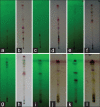Pharmacognostical Standardization of Upodika- Basella alba L.: An Important Ayurvedic Antidiabetic Plant
- PMID: 28182032
- PMCID: PMC5255969
- DOI: 10.4103/0257-7941.195411
Pharmacognostical Standardization of Upodika- Basella alba L.: An Important Ayurvedic Antidiabetic Plant
Abstract
Objective: To establish the pharmacognostic standards for the correct identification and standardization of an important Antidiabetic plant described in Ayurveda.
Materials and methods: Standardization was carried out on the leaf and stem of Basella alba L. with the help of the macro-morphological, microscopic, physicochemical and qualitative phytochemical studies.
Results: Several specific characters were identified viz. clustered calcium oxalate crystals in the cortex region, absence of trichomes, succulent, thick, mucilaginous, fibrous stem. Rubiaceous type of stomata on both sides of the leaf. Quantitative microscopy along with physicochemical and qualitative phytochemical analysis were also established.
Conclusion: The pharmacognostic standards could serve as the reference for the proper identification of the Basella alba L. which is an important anti-diabetic plant described in Ayurveda.
Keywords: Anti-diabetic; Basella alba; microscopy; standardization; thin layer chromatography.
Conflict of interest statement
There are no conflicts of interest.
Figures






References
-
- Grubben GJ, Denton OA. Plant resources of tropical Africa. Vegetable. Vol. 4. Wageningen, Leiden: PROTA Foundation, Backhuys, CTA; 2004. pp. 103–11.
-
- Rathee S, Ahuja D, Rathee P, Thanki M, Rathee D. Cytotoxic and antibacterial activity of Basella alba whole plant: A relatively unexplored plant. Pharmacol Online. 2010;3:651–8.
-
- Deshmukh SA, Gaikwad DK. A review of the taxonomy, ethnobotany, phytochemistry and pharmacology of Basella alba (Basellaceae) J Appl Pharm Sci. 2014;4:153–65.
-
- Anonymous. The Wealth of India, Raw Materials. Revised Edition. Vol. 2. New Delhi: Publications and Information Directorate, Council of Scientific and Industrial Research; 1988. pp. 50–2.
-
- Baskaran T. It Isn't Spinach, but it's as Nutritious. The Hindu. [Last accessed on 2012 Aug 08]. Available from: http://www.thehindu.com/features/metroplus/Food/it-isnt-spinach-but-its-... .
LinkOut - more resources
Full Text Sources
Other Literature Sources
Miscellaneous

